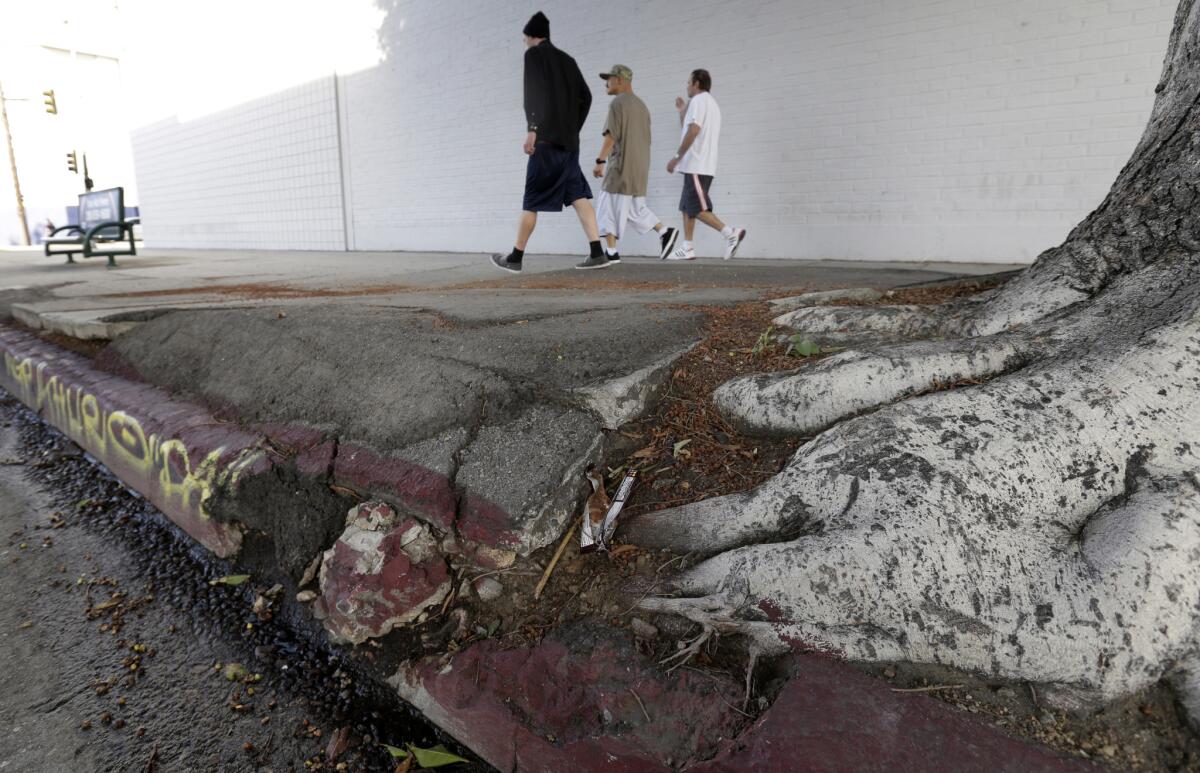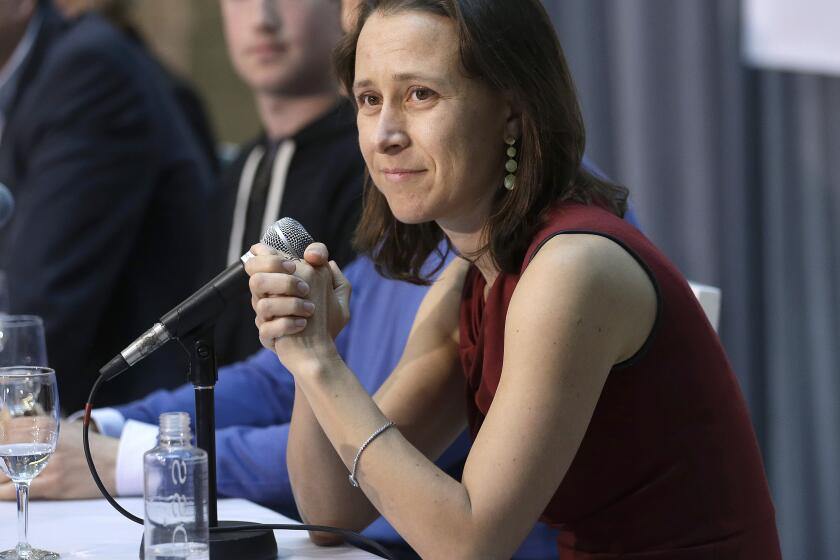Editorial: Making property owners responsible for sidewalk repairs will be unpopular, but it’s the right thing to do

Pedestrians walk along a buckled sidewalk in Los Angeles on Tuesday, March 15, 2016.
- Share via
More than 40 years ago, the city of Los Angeles adopted a well-intentioned but ultimately disastrous ordinance that transferred the responsibility for fixing sidewalks damaged by tree roots from property owners to the city. The idea made sense — sidewalks are used by the public at large and homeowners had, for the most part, not planted the trees that were causing the damage.
So why was it disastrous? Because the city never fulfilled its obligation to fund and fix the sidewalks, leaving them a cracked, crumpled, dangerous mess.
City officials over the years have pondered possible solutions, such as raising taxes or cutting spending to pay for the repairs, or making property owners cover the cost. But they consistently avoided making the long-term, politically difficult decisions required. The condition of the walkways worsened — at one point, officials estimated that 4,600 miles of sidewalk needed to be fixed — and the total price tag continued to rise, which only made it harder for city leaders to act. It took a lawsuit by disabled residents to force Mayor Eric Garcetti and the City Council to commit to spend $1.4 billion over the next 30 years on sidewalk repairs.
The city never fulfilled its obligation to fund and fix the sidewalks, leaving them a cracked, crumpled, dangerous mess.
The settlement, reached last year, also gave city leaders the impetus to come up with a plan to replace L.A.’s failed sidewalk policy. This week, the City Council may finally adopt one — a “fix and release” approach under which the city would repair the sidewalks first and then return responsibility to property owners.
If approved, the city would launch a city-funded repair program, prioritizing sidewalks near government and commercial facilities, as well as those with severe damage and walkways in heavily traveled corridors before moving on to other residential areas. Working through the backlog could take decades, so the city would offer property owners a rebate of 50% of the repair cost if they fix the sidewalk themselves in the first three years of the program. The city would offer a warranty on the repairs — 20 years for residential properties, 5 years for commercial and industrial properties — during which time the city would cover one repair.
For all this policy to work, the council and mayor will have to repeal the law that made the city responsible for tree-related sidewalk damage. (Otherwise, the city wouldn’t be able to hold property owners responsible for future repairs.)
This will probably be unpopular. Homeowners and business owners question why they should be saddled with the expense and liability of maintaining and repairing a public space. Some say sidewalks should be managed and funded as a core part of the city’s transportation system, like roads, rather than fixed in a piecemeal fashion by property owners.
Those are valid points. However California’s Street and Highway Code states that lot owners shall maintain the sidewalks, and the majority of jurisdictions follow that law. Besides, the last four decades demonstrate that if the responsibility is left to the city, repairs won’t be adequately funded. The settlement commits the city to 30 years of sidewalk spending, but the city needs a plan to forever maintain this crucial piece of public infrastructure. The fix-and-release program is a good compromise that should be adopted.
Of course, there is still a lot of work ahead, and city leaders will need to balance competing priorities. For example, the city wants to fix the greatest number of sidewalk miles with limited funds, but the desire to rebuild sidewalks in a way that captures stormwater and boosts the local water supply might mean that fewer sidewalks are fixed.
Likewise, how can the city preserve as many healthy, mature trees as possible for shade and other environmental benefits, when many of those big old trees are responsible for the vast majority of busted sidewalks? The city’s Urban Forestry Division is supposed to come up with criteria for when to keep and when to cut trees, and how to prevent roots from damaging sidewalks in the future. But the division’s budget was drastically cut during the last recession and now, street trees are only trimmed every 18 years or so. It would be patently unfair to make property owners responsible for sidewalk maintenance if the city won’t uphold its responsibility for public tree maintenance. The mayor and council must make sure tree care is funded going forward. It’s time to Los Angeles city leaders demonstrate that they’ve learned from the mistakes of the past.
Follow the Opinion section on Twitter @latimesopinion and Facebook
More to Read
A cure for the common opinion
Get thought-provoking perspectives with our weekly newsletter.
You may occasionally receive promotional content from the Los Angeles Times.










